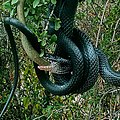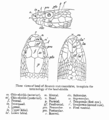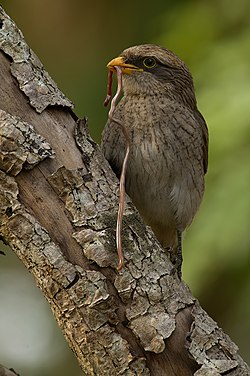Portal:Snakes
The Snake PortalSnakes are elongated, limbless, carnivorous reptiles of the suborder Serpentes (/sɜːrˈpɛntiːz/). Like all other squamates, snakes are ectothermic, amniote vertebrates covered in overlapping scales. Many species of snakes have skulls with several more joints than their lizard ancestors, enabling them to swallow prey much larger than their heads (cranial kinesis). To accommodate their narrow bodies, snakes' paired organs (such as kidneys) appear one in front of the other instead of side by side, and most have only one functional lung. Some species retain a pelvic girdle with a pair of vestigial claws on either side of the cloaca. Lizards have independently evolved elongate bodies without limbs or with greatly reduced limbs at least twenty-five times via convergent evolution, leading to many lineages of legless lizards. These resemble snakes, but several common groups of legless lizards have eyelids and external ears, which snakes lack, although this rule is not universal (see Amphisbaenia, Dibamidae, and Pygopodidae). Living snakes are found on every continent except Antarctica, and on most smaller land masses; exceptions include some large islands, such as Ireland, Iceland, Greenland, and the islands of New Zealand, as well as many small islands of the Atlantic and central Pacific oceans. Additionally, sea snakes are widespread throughout the Indian and Pacific oceans. Around thirty families are currently recognized, comprising about 520 genera and about 3,900 species. They range in size from the tiny, 10.4 cm-long (4.1 in) Barbados threadsnake to the reticulated python of 6.95 meters (22.8 ft) in length. The fossil species Titanoboa cerrejonensis was 12.8 meters (42 ft) long. Snakes are thought to have evolved from either burrowing or aquatic lizards, perhaps during the Jurassic period, with the earliest known fossils dating to between 143 and 167 Ma ago. The diversity of modern snakes appeared during the Paleocene epoch (c. 66 to 56 Ma ago, after the Cretaceous–Paleogene extinction event). The oldest preserved descriptions of snakes can be found in the Brooklyn Papyrus. (Full article...) Selected article -Most snakebites are caused by non-venomous snakes. Of the roughly 3,700 known species of snake found worldwide, only 15% are considered dangerous to humans. Snakes are found on every continent except Antarctica. There are two major families of venomous snakes, Elapidae and Viperidae. 325 species in 61 genera are recognized in the family Elapidae and 224 species in 22 genera are recognized in the family Viperidae, In addition, the most diverse and widely distributed snake family, the colubrids, has approximately 700 venomous species, but only five genera—boomslangs, twig snakes, keelback snakes, green snakes, and slender snakes—have caused human fatalities. Since reporting is not mandatory in many regions of the world, snakebites often go unreported. Consequently, no accurate study has ever been conducted to determine the frequency of snakebites on the international level. However, some estimates put the number at 1.2 to 5.5 million snakebites, 421,000 envenomings, resulting in perhaps 20,000 deaths, but the actual number of deaths may be as high as 94,000. Many people who survive bites nevertheless suffer from permanent tissue damage caused by venom, leading to disability. Most snake envenomings and fatalities occur in South Asia, Southeast Asia, and sub-Saharan Africa, with India reporting the most snakebite deaths of any country. An analysis cross-referencing exposure to venomous snakes and accessibility of medical treatment identified that 93 million people worldwide are highly vulnerable to dying from snakebite. (Full article...)Did you know (auto-generated) -
More did you know? -
Quality ContentFeatured snake-related articles - George Went Hensley - List of snakes of Trinidad and Tobago Good snake-related articles - Agkistrodon piscivorus - Bitis arietans - Bitis gabonica - Black mamba - Black-necked spitting cobra - Eastern green mamba - Forest cobra - Hydrophiinae - Many-banded krait - Nerodia clarkii - Russell's viper - Snake scales - Vipera berus - Western green mamba General imagesThe following are images from various snake-related articles on Wikipedia.
Selected image
TopicsLists - List of snakes by common name - List of Serpentes families - List of snake genera - List of dangerous snakes
Families - Acrochordidae - Aniliidae - Anomochilidae - Boidae - Bolyeriidae - Colubridae - Cylindrophiidae - Elapidae - Loxocemidae - Pythonidae - Tropidophiidae - Uropeltidae - Viperidae - Xenopeltidae - Anomalepididae - Leptotyphlopidae - Typhlopidae Anatomy and physiology - Infrared sensing in snakes - Pelvic spur - Snake scales - Snake skeleton SubcategoriesRelated portalsNeed help?Do you have a question about Snakes that you can't find the answer to? Consider asking it at the Wikipedia reference desk. Snakes in the newsNo recent news Things you can do
Help at WikiProjects:
Associated WikimediaThe following Wikimedia Foundation sister projects provide more on this subject:
Discover Wikipedia using portals |






























































